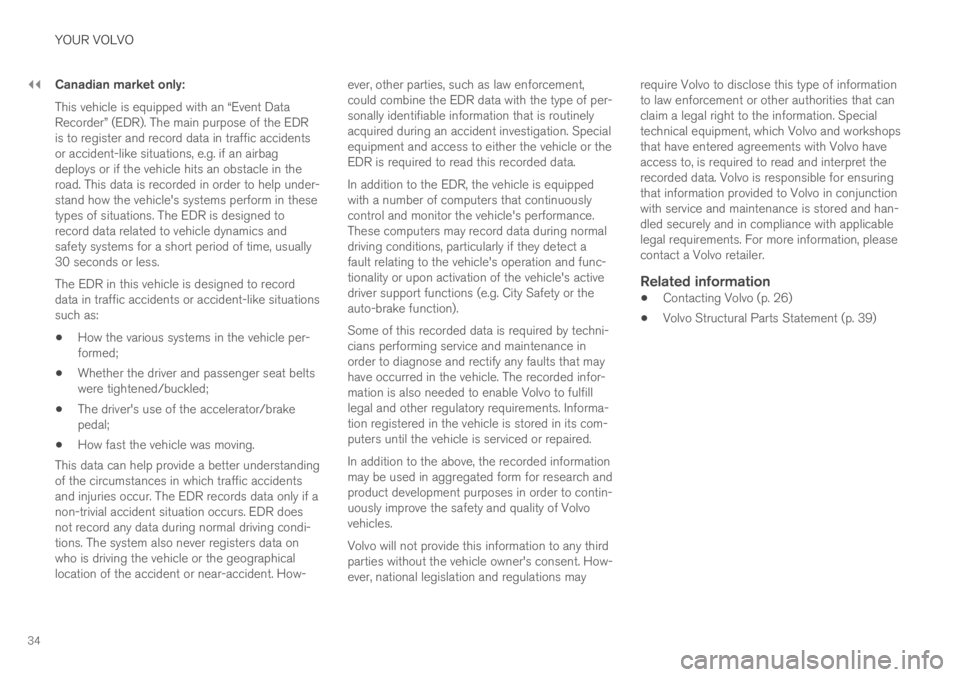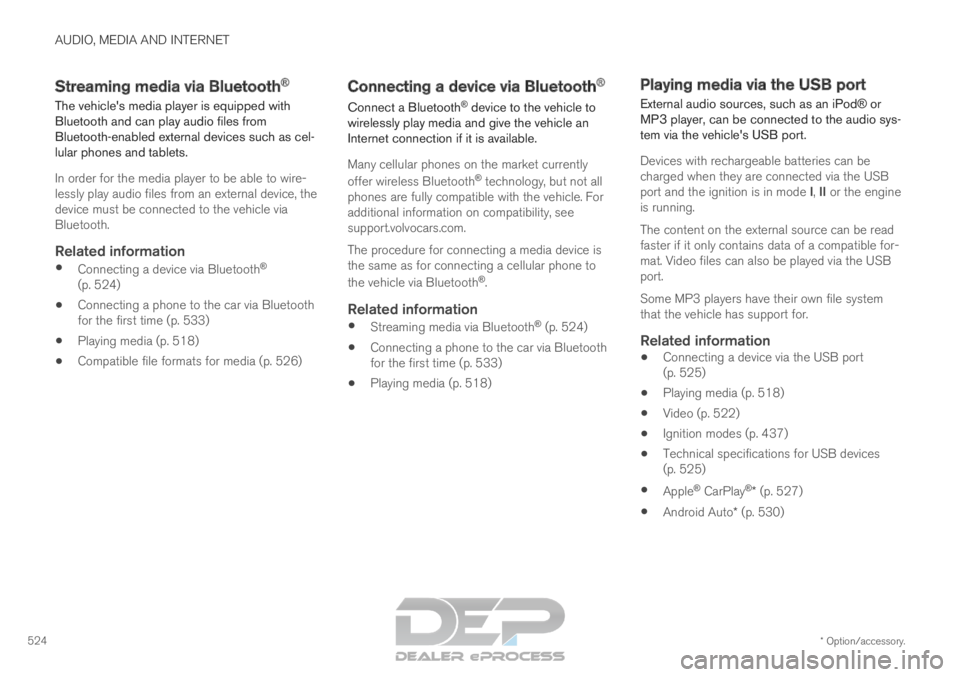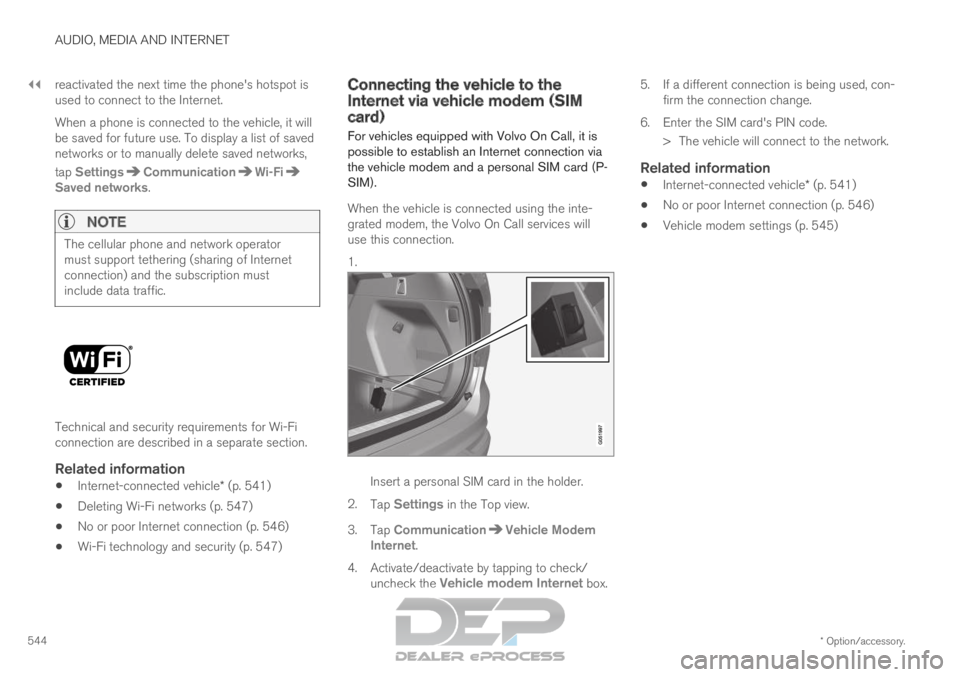technical data VOLVO XC90 TWIN ENGINE 2019 Owners Manual
[x] Cancel search | Manufacturer: VOLVO, Model Year: 2019, Model line: XC90 TWIN ENGINE, Model: VOLVO XC90 TWIN ENGINE 2019Pages: 697, PDF Size: 10.33 MB
Page 36 of 697

||
YOUR VOLVO
34
Canadian market only:
This vehicle is equipped with an “Event DataRecorder” (EDR). The main purpose of the EDRis to register and record data in traffic accidentsor accident-like situations, e.g. if an airbagdeploys or if the vehicle hits an obstacle in theroad. This data is recorded in order to help under-stand how the vehicle's systems perform in thesetypes of situations. The EDR is designed torecord data related to vehicle dynamics andsafety systems for a short period of time, usually30 seconds or less.
The EDR in this vehicle is designed to recorddata in traffic accidents or accident-like situationssuch as:
How the various systems in the vehicle per-formed;
Whether the driver and passenger seat beltswere tightened/buckled;
The driver's use of the accelerator/brakepedal;
How fast the vehicle was moving.
This data can help provide a better understandingof the circumstances in which traffic accidentsand injuries occur. The EDR records data only if anon-trivial accident situation occurs. EDR doesnot record any data during normal driving condi-tions. The system also never registers data onwho is driving the vehicle or the geographicallocation of the accident or near-accident. How-
ever, other parties, such as law enforcement,could combine the EDR data with the type of per-sonally identifiable information that is routinelyacquired during an accident investigation. Specialequipment and access to either the vehicle or theEDR is required to read this recorded data.
In addition to the EDR, the vehicle is equippedwith a number of computers that continuouslycontrol and monitor the vehicle's performance.These computers may record data during normaldriving conditions, particularly if they detect afault relating to the vehicle's operation and func-tionality or upon activation of the vehicle's activedriver support functions (e.g. City Safety or theauto-brake function).
Some of this recorded data is required by techni-cians performing service and maintenance inorder to diagnose and rectify any faults that mayhave occurred in the vehicle. The recorded infor-mation is also needed to enable Volvo to fulfilllegal and other regulatory requirements. Informa-tion registered in the vehicle is stored in its com-puters until the vehicle is serviced or repaired.
In addition to the above, the recorded informationmay be used in aggregated form for research andproduct development purposes in order to contin-uously improve the safety and quality of Volvovehicles.
Volvo will not provide this information to any thirdparties without the vehicle owner's consent. How-ever, national legislation and regulations may
require Volvo to disclose this type of informationto law enforcement or other authorities that canclaim a legal right to the information. Specialtechnical equipment, which Volvo and workshopsthat have entered agreements with Volvo haveaccess to, is required to read and interpret therecorded data. Volvo is responsible for ensuringthat information provided to Volvo in conjunctionwith service and maintenance is stored and han-dled securely and in compliance with applicablelegal requirements. For more information, pleasecontact a Volvo retailer.
Related information
Contacting Volvo (p. 26)
Volvo Structural Parts Statement (p. 39)
Page 526 of 697

AUDIO, MEDIA AND INTERNET
* Option/accessory.
524 Streaming media via Bluetooth
®
The vehicle's media player is equipped with
Bluetooth and can play audio files from
Bluetooth-enabled external devices such as cel-
lular phones and tablets.
In order for the media player to be able to wire-
lessly play audio files from an external device, the
device must be connected to the vehicle via
Bluetooth.
Related information
Connecting a device via Bluetooth ®
(p. 524)
Connecting a phone to the car via Bluetooth
for the first time (p. 533)
Playing media (p. 518)
Compatible file formats for media (p. 526) Connecting a device via Bluetooth
®
Connect a Bluetooth ®
device to the vehicle to
wirelessly play media and give the vehicle an
Internet connection if it is available.
Many cellular phones on the market currently
offer wireless Bluetooth ®
technology, but not all
phones are fully compatible with the vehicle. For
additional information on compatibility, see
support.volvocars.com.
The procedure for connecting a media device is
the same as for connecting a cellular phone to
the vehicle via Bluetooth ®
.
Related information
Streaming media via Bluetooth ®
(p. 524)
Connecting a phone to the car via Bluetooth
for the first time (p. 533)
Playing media (p. 518) Playing media via the USB port
External audio sources, such as an iPod® or
MP3 player, can be connected to the audio sys-
tem via the vehicle's USB port.
Devices with rechargeable batteries can be
charged when they are connected via the USB
port and the ignition is in mode I, II or the engine
is running.
The content on the external source can be read
faster if it only contains data of a compatible for-
mat. Video files can also be played via the USB
port.
Some MP3 players have their own file system
that the vehicle has support for.Related information
Connecting a device via the USB port
(p. 525)
Playing media (p. 518)
Video (p. 522)
Ignition modes (p. 437)
Technical specifications for USB devices
(p. 525)
Apple ®
CarPlay ®
* (p. 527)
Android Auto* (p. 530)
Page 546 of 697

||AUDIO, MEDIA AND INTERNET
* Option/accessory.
544 reactivated the next time the phone's hotspot is
used to connect to the Internet.
When a phone is connected to the vehicle, it will
be saved for future use. To display a list of saved
networks or to manually delete saved networks,
tap
Settings Communication Wi-Fi
Saved networks
.
NOTE
The cellular phone and network operator
must support tethering (sharing of Internet
connection) and the subscription must
include data traffic.
Technical and security requirements for Wi-Fi
connection are described in a separate section.
Related information
Internet-connected vehicle* (p. 541)
Deleting Wi-Fi networks (p. 547)
No or poor Internet connection (p. 546)
Wi-Fi technology and security (p. 547) Connecting the vehicle to the
Internet via vehicle modem (SIM
card)
For vehicles equipped with Volvo On Call, it is
possible to establish an Internet connection via
the vehicle modem and a personal SIM card (P-
SIM).
When the vehicle is connected using the inte-
grated modem, the Volvo On Call services will
use this connection.
1. Insert a personal SIM card in the holder.
2. Tap Settings in the Top view.
3.
Tap Communication Vehicle Modem
Internet .
4.
Activate/deactivate by tapping to check/
uncheck the Vehicle modem Internet box. 5.
If a different connection is being used, con-
firm the connection change.
6. Enter the SIM card's PIN code. > The vehicle will connect to the network.
Related information
Internet-connected vehicle* (p. 541)
No or poor Internet connection (p. 546)
Vehicle modem settings (p. 545)